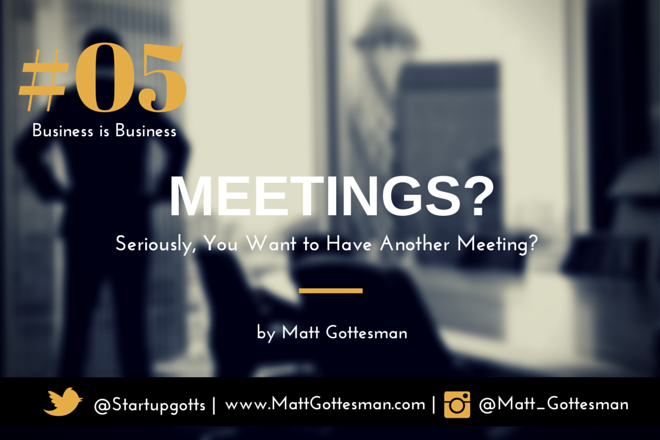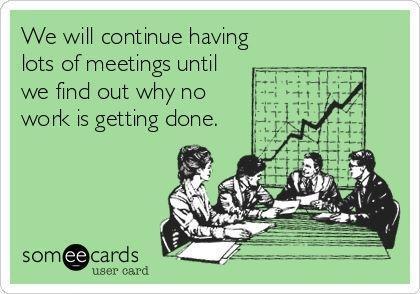What’s with having so many meetings? Seriously? Why are there some people who are in meetings all day, everyday? When does the work get done? What’s being accomplished? And why are there so many meetings between two sets of individuals before executing a contract to work together?
Listen, I totally get it. Business meetings allow us to ask all the appropriate questions, get to know each other, talk about the endless possibilities and align the worlds. However, as I’m getting older and further on in my professional endeavors, I’m finding that we should strive for “one and done” with our meetings.
Now, before you break out “cultural” context, multi-million dollar investments, Venture Capital and Private Equity deals, and business mentoring / advising, I want you, the reader, to know that I’m talking about the initial meetings that take place to get to know whether or not you’re moving forward with the business relationship and the deal. This does not mean you have to complete the business deal, just that you know whether or not you are moving forward to make it happen.
The fact is, I come from a school of thought that relationships are the most powerful component of doing business with another individual, entity or global organization. I firmly stand by that perspective, but I also believe it’s important to treat those relationships with the utmost respect when it comes to meetings. In other words, it shows even more respect to the relationship, if we don’t abuse the “endless meeting syndrome.”
In General, I’m Noticing Two Types of Meetings
The first type of meeting gets straight to the point and accomplishes everything in one sitting. Meaning, the parties were able to establish that they have complimentary strategic initiatives for a win-win situation, a keen sense of understanding what they both bring to the table and a relationship they feel comfortable with. They usually close the meeting with the next steps already happening.
The second type of meeting, which in my opinion happens more often than it should, consists of a series of meetings that lead to more meetings to discuss the possibilities that can be established in future meetings.
While I’m being facetious, this type of “chain” of meetings can often feel that way. The initial meeting takes place and everyone gets excited, but then there’s no “close” or next steps. This then leads to a “follow up” meeting to discuss the previous meeting’s topics.
In my professional opinion, too many meetings blur the lines and cause inefficiency and lack of execution of initiatives. As Jillian Major, a fellow digital consultant friend of mine puts it:
It’s as if everyone is just talking about doing and then no one is doing.
Full disclosure: I, too, have played the “too many meetings game” earlier on in my professional career, but I have since learned the value of conducting significantly less. Why? Because then I reserve more of my precious time to executing the work that matters and brings in a return.
I have also found that it allows me to focus on only having meetings that make sense. Some are business related and some are reserved to a smaller amount of people who are my mentors and advisors that I can constantly learn from.
Additionally, in my efforts to work on my meeting etiquette, I believe I have created a formula for conducting better meetings based off of my interactions with some pretty smart Venture Capitalists, MBA Professors, Business Advisors and a few seasoned CEO’s.
The One-And-Done Meeting Formula
I have learned 4 inevitable principles that seem to be of help to me for business related meetings. This goes for both asking for meetings and receiving requests for them. Hence, I offer these principles to you:
- Ask Why?
- Apply the 80/20 rule
- Keep Strict Agendas With Room for Q&A
- The Art of Scheduling
#1: Ask Why?
When someone approaches you to have a meeting, ask him/her why they want to have it. What is it in regards to? This is respectful to both you, the person being requested for a meeting, and the individual inquiring. The same holds true if you are the person asking for the meeting. In your email, tell the individual ahead of time why you are requesting a meeting so they don’t have to ask.
At the end of the day, I want to know at least one of several things:
- Whether or not I can help you.
- Is there some aspect of business in it for me? Will my services or participation be needed?
- Are you seeking information, and if so, what information do you need.
Ideally, in any business setting, I’d like to be prepared. What business professional doesn’t like to be prepared? The more I know ahead of time, the better I can approach the meeting.
#2: Apply the 80-20 Rule
If you haven’t heard about the 80-20 rule (The Pareto Principle), then you need to learn more about it.
Wikipedia – The 80-20 rule states that, for many events, roughly 80% of the effects come from 20% of the causes. It is a common rule of thumb in business; e.g., “80% of your sales come from 20% of your clients”. Mathematically, the 80–20 rule is roughly followed by a power law distribution (also known as a Pareto distribution) for a particular set of parameters, and many natural phenomena have been shown empirically to exhibit such a distribution.
If we apply the fact that 20% of our customers, interactions, sales, PLUG ANYTHING IN HERE, leads to 80% of our results, then we must apply the same thinking to meetings.
I recommend a 2-fold approach. First, try to schedule 20% or less of your work week to be in meetings. For normal 40 hour work weeks, that’s roughly 8 hours.
Second, to optimize which meetings you should actually partake in, start by carefully observing which current meetings have been the most productive and why. Chances are, 20% of all your meetings were the most productive and yielded you 80% of your results. Now observe why that 20% was successful and create a checklist of success factors that came from those meetings.
From here on out you choose accordingly.
#3: Keep Strict Agendas With Room For Q&A
If you’re requesting a meeting and the individual grants it, be respectful. Go into the meeting with a clear goal. You should outline what you want to achieve and tell him or her up front why you are there. Once you’ve introduced the conversation, then you can go into the various details. Keep in mind, in your first email just tell them what it’s in regards to and then present them more details in person.
If someone is requesting a meeting from you and you agree, ask them to provide you with a brief outline or agenda if possible. Otherwise, they should tell you in their email what it’s in regards to.
#4: The Art of Scheduling
This idea is simple. You want to schedule meetings when you are at your optimal brain capacity in the day, However, be careful not to take away from your capacity to perform your work. So long as you know your window for performance, and you’re only scheduling the appropriate meetings according to the 80-20 rule, you should be fine.
In Conclusion
In my continuous journey to master time, structuring my meetings has drastically increased my weekly production output.
For me, this is the first step in restructuring my entire productivity schedule. Why? Because I’d like to be able to have more productive output, but with reduced hours.
They say the average employee spends 2.5 hours of their 8-hour workday doing actual work. Because I’m an independent consultant, I do not have the luxury of wasting time. If I work 10 hours on a given day, I’m attempting to utilize every minute of that day. Now that I am mastering meetings, the next step is to master operations by automating tasks that work for me whether I’m working or not. That’s a post for a whole different day.
In conclusion, I feel meetings are both a gift and a curse. We must learn to take the right ones, say no to all the others, and remain a little flexible for the ones we’re still unsure about. In the mean time, we must consider the following
- Be prepared prior to the meeting.
- Be concise during the meeting.
- State your value proposition or offering.
- Close the meeting with the next steps already in mind
And for the love of business, please stop having so many meetings that don’t matter.
Did you like this post? Do you know of people who are constantly in meetings? Are you always being asked into meetings? What do you do?
Please feel free to start a conversation below.
##
Photo Credit (Header Graphic Photo): Photodune.net










